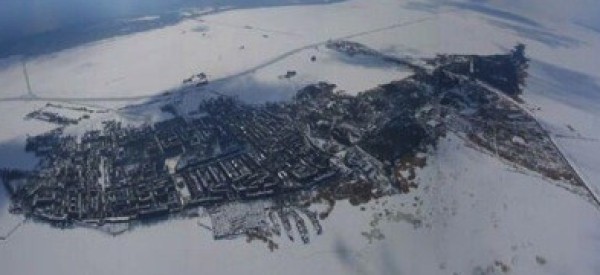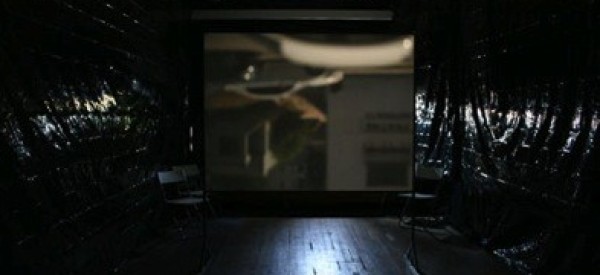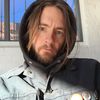November 2 2013
34.09n / -118.25w
9:00 a.m.
On January 13 2014, I will be the Artist in Residence at the National Center for Contemporary Art in Kronstadt, Russia. I will be documenting this experience in a series of posts that begin here in Los Angeles with the preparation for the trip and continue through the entirety of the residency coming to a close with my return home to Echo Park.
The posts will be a combination of journal entries and process documents that follow my experience throughout my time on a fortified Russian island that sits in the frozen Baltic Sea off the coast of St. Petersburg.

Photo Credit: NCCA Arsenal
Kronstadt is a Russian seaport town, located on Kotlin Island, 30 kilometers west of Saint Petersburg near the head of the Gulf of Finland. It is under the administration of the federal city of Saint Petersburg and is also its main port. In March 1921 it was the site of the Kronstadt rebellion.
Traditionally, the seat of the Russian admiralty and the base of the Russian Baltic Fleet were located in Kronstadt guarding the approaches to Saint Petersburg. The historic center of the city and its fortifications are part of the World Heritage Site Saint Petersburg and Related Groups of Monuments.
Kronstadt was founded by Peter the Great, who took the island of Kotlin from the Swedes in 1703. Pushkin's great-grandfather, Abram Petrovich Gannibal, oversaw its construction. The first fortifications were inaugurated on 18 May 1704.
The work I will produce will be based on maritime details and will explore subjects including sail shapes, humans' long accepted trust in sails, the lines of ships and ports, the silent lighthouse perched on a frozen bay, navigation across a mass that spends half its life as a liquid, so on and so forth.
Along with the paintings, drawings, photographs and video, I will also be writing a series of essays on various aspects of the island. In particular the use of Fort Alexander as a Plague research center from 1894-1917 after the discovery of the plague pathogen by Alexandre Yersin in 1894. Converting the fort into a bacteriology research facility the scientists took a structure that had previously been designed to keep the enemy out, and brought the threat to mankind inside of the fort, which essentially created something of a deliberate Trojan Horse.
I am also interested in the tide gauge in Kronstadt, which is one of the longest operational tidal sites in the world, dating to 1777. The tide gauge pavilion is a zero-level of the Baltic system depths and heights. All depths and altitudes (even the heights of spacecraft flight) in Russia and some other countries (former Russian Empire) are measured from the level of Kronstadt sea gauge. What if we thought of such a gauge in relation to the human body consisting of 60 percent water? Could it track our reason and reactions? This is an idea I plan to explore in depth.
Like many of my contemporaries in Los Angeles, I work across multiple disciplines that allow for attention to be directed toward my investigations rather than restricted by a commitment to a single medium. Working in this way allows for opportunity to explore details that cannot be seen from a singular view. From essays to installation, sculpture to sound, subjects can be focused on with clarity only possible through multiple vantage points.
In 2010, I presented "Camera Obscura" at Machine Project in Los Angeles. I turned the entire gallery into a large camera obscura, which allowed visitors to watch the city rush by on a two-way projection screen while they were bathed in the light from the strange phenomenon. Later that year I took the classic book To Kill A Mocking Bird and rearranged the letters of each word then published an edition of 10 copies of the scrambled text now titled "illiteral" showing them as art objects at the exhibition RE:FORM School in NYC. These works fall somewhere between sculpture and ephemera. The following year I photographed the interior space of the Berkley Art Museum and created visual sheet music by tracing the lines of its stark architecture. This was later used by 14 performers in the "Glass Music" performance that filled the cavernous space with drones floating from one level to the next.
Each series or piece has a conceptual foundation and follows, often times, strict guidelines while not letting the reason constrict the aesthetic nature of the work. Whether it is a painting, sculpture or site-specific installation the work must stand on its own without the aid of its purpose if need be. Exploring ideas that range from humans desire to secure memories and often times retaining them in the form of objects (Heirlooms Series) to the natural phenomenon of the worlds signing dunes (Booming Dunes: A Study in 35 parts) to the discarded furniture that make cameos on the streets of Los Angeles (Reductions Series), I am interested in addressing what we consider are our "needs" and the looming fact that all is temporary.
This blog will track my progress and process. Upon conclusion, it will be a completed work in itself. Balancing somewhere between viewer to voyeur, readers will have a chance to follow my experiences in a land far different than Los Angeles or most other American cities.
-- j.frede

Camera Obscura -- Machine Project, Los Angeles -- Photo Credit: j.frede

Heirlooms; Friday Morning - Photo Credit: j.frede
